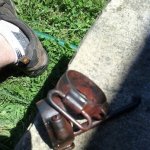Using raw coal for this process is new to me. I would be concerned the wrong grade of coal might have too much sulphur or oil in it. Charcoal from bone and coconut husk and hardwood are more commonly used, and they've had moisture, oils and whatnot burned out of them.
You can make your own charcoal from dinner plate bones by heating it in closed pipe that has a vent hole for steam and air expansion. You can break up charcoal grill brickettes for hardwood charcoal, though you want to be aware the shapes of the carbon sources can affect the coloring pattern, so you might want to sift out dust. Or you might want to get some hardwood plane shavings or other scrap shapes make charcoal with them, for example. Some fellows tie shoelace size strips of leather around the work to get a stripe pattern, so you don't necessarily have to have all pre-charred carbon sources.
I forget what acid is in the Birchwood Casey remover. Probably phosphoric, which shouldn't be bad, but some used to use hydrochloric. Some acids can activate the surface and make it more prone to rusting. I used to find that would happen with some cold blues that had nitric acid in them, too. The cure I discovered was to have a strongly alkaline cleaner to apply immediately after the exposure to the acid was complete. It penetrated and neutralized the acid. I used Formula 409, but you can take a quart of water and dissolve a couple of tablespoons of baking soda in it, then add a short squirt of the Dawn to help it wet faster. As soon as you've done a quick rough rinse off of the remover, drop the part in the baking soda solution for a couple of minutes and shake it around in the stuff to get it throughout the nooks and crannies.
While the parts are still in the baking soda, start a clean pot of distilled water (grocery store gallon jug of distilled (not mineral) water is just fine) to boiling on the stove. Wearing rubber gloves so you can't contaminate the parts with your skin oils, rinse the soapy baking soda solution off very thoroughly in running water. Then hang the parts on pieces of wire and suspend them in the boiling distilled water for at least 5 minutes. This does two things. One is that it converts any microscopic red rust that has formed into blue/black magnetite. That is how conversion of red rust in rust bluing is done. Second, it gets the part hot, so when you pull it out of the water and shake the excess water off, its surface dries almost immediately. Doing so in the presence of heat and water vapor causes a thin layer of blue oxide to form. It can be so thin you can't see it with the naked eye, but it's there. That thin layer of blue actually protects the steel from forming red rust for a little while (hours to days, depending on your atmospheric conditions). Distilled water won't leave water spots that could affect your final work; also some tap water has minerals in it that prevent it from converting red rust to blue (I found this out the hard way).
Be careful not to touch the metal with bare hands or greasy gloves. Use tongs if you have to, or wear very clean rubber surface gloves. Hang the parts from the wire rather than let them touch any paper product, as those often have acid traces in them. I keep a roll of stainless MIG welding wire just for this purpose. Cheap, easy to clip to a length and it won't contaminate anything. It is, however, springy. You can use the softer stainless wire that comes in a roll at Lowe's instead, if you want to. Iron wire is technically OK. Just be aware you normally have to degrease it before using it.
That should give you time to pack it up charcoal and start the color case hardening process. If you can't get to it right away, store the parts and their hanging wires in a jar submerged in virgin naphtha or virgin mineral spirits. When you are ready to work again, pull them out and let them hang until dry then pack them in the carbon sources and run the hardening process. I would avoid touching the part with your bare finger during any of this.
Nick

